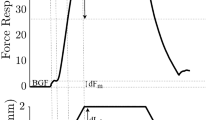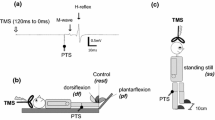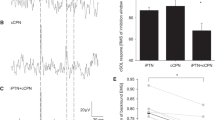Abstract
To study the biomechanics of the calcaneal ten-don's complex insertion onto the calcaneus, we measured torque-time trajectories exerted by the triceps surae and tibialis anterior muscles in eight unanesthetized decerebrate cats using a multi-axis force-moment sensor placed at the ankle joint. The ankle was constrained to an angle of 110° plantarflexion. Muscles were activated using crossed-extension (XER), flexion (FWR), and caudal cutaneous sural nerve (SNR) reflexes. Torque contributions of other muscles activated by these reflexes were eliminated by denervation or tenotomy. In two animals, minia-ture pressure transducers were implanted among tendon fibers from the lateral gastrocnemius (LG) muscle that insert straight into the calcaneus or among tendon fibers from the medial gastrocnemius (MG) that cross over and insert on the lateral aspect of calcaneus. Reflexively evoked torques had the following directions: FWR, dorsiflexion and adduction; SNR, plantarflexion and abduction; and XER, plantarflexion and modest abduction or adduction. The proportion of abduction torque to plantarflexion torque was always greater for SNR than XER; this difference was about 50% of the magnitude of abduction torque generated by tetanic stimulation of the peronei. During SNR, pressures were higher in regions of the calcaneal tendon originating from MG than regions originating from LG. Similarly, pressures within the MG portion of the calcaneal tendon were higher during SNR than during XER, although these two reflexes produced matched ankle plantarflexion forces. Selective tenotomies and electromyographic recordings further demonstrated that MG generated most of the torque in response to SNR, while soleus, LG, and MG all generated torques in response to XER. Previous studies have shown that interneurons processing afferent information from both XER and SNR differentially excite the MG and LG motoneuron pools. Further, our data demonstrate that forces produced by this differential activation are preserved throughout the calcaneal tendon. We conclude that selective activation of the gastrocnemei permits the animal to take advantage of the complex mechanical insertion of MG and LG at calcaneus and, specifically, to generate different torques at the ankle joint in response to different reflex activations.
Similar content being viewed by others
References
Bonasera SJ, Lawrence JH III, Nichols TR (1992) Selective recruitment within triceps surae of the decerebrate cat alters the direction of ankle torque properties. Soc Neurosci Abstr 18:1549
Burke RE (1991) Selective recruitment of motor units. In: DR Humphrey, H-J Freund (eds) Motor control: concepts and issues. Wiley, New York, pp 5–21
Clark BD, Dacko SM, Cope TC (1992) Cutaneous afferent stimulation and motoneuron recruitment in medial gastrocnemius of the decerebrate cat. Soc Neurosci Abstr 18:1549
English AW, Letbetter WD (1982) Anatomy and innervation patterns of cat lateral gastrocnemius and plantaris muscles. Am J Anat 164:67–77
Hagbarth K-E (1952) Excitatory and inhibitory skin areas for flexor and extensor motoneurons. Acta Physiol Scand 26:1–58
Henneman E, Somjen G, Carpenter DO (1965) Functional significance of cell size in spinal motoneurons. J Neurophysiol 28:560–580
Kanda K, Burke RE, Walmsley B (1977) Differential control of fast and slow twitch motor units in the decerebrate cat. Exp Brain Res 29:57–74
LaBella LA, Kehler JP, McCrea DA (1989) A differential synaptic input to the motor nuclei of triceps surae from the caudal and lateral cutaneous sural nerves. J Neurophysiol 61:291–301
Lawrence JH III, Nichols TR (1993) The effect of ankle joint angle on the ankle torque profile in the cat. Physiologist 36:A22
Lawrence JH III, Nichols TR, English AW (1993) Cat hindlimb muscles exert substantial torques outside the sagittal plane. J Neurophysiol 69:282–285
Otten E (1988) Concepts and models of functional architecture in skeletal muscle. Exerc Sport Sci Rev 16:89–137
Parsons FG (1894) On the morphology of the tendo-achillis. J Anat Physiol 28:414–418
Young RP, Scott SH, Loeb GE (1992) An intrinsic mechanism to stabilize posture — Joint-angle-dependent moment arms of the feline ankle muscles. Neurosci Lett 145:137–140
Author information
Authors and Affiliations
Rights and permissions
About this article
Cite this article
Nichols, T.R., Lawrence, J.H. & Bonasera, S.J. Control of torque direction by spinal pathways at the cat ankle joint. Exp Brain Res 97, 366–371 (1993). https://doi.org/10.1007/BF00228708
Received:
Accepted:
Issue Date:
DOI: https://doi.org/10.1007/BF00228708




